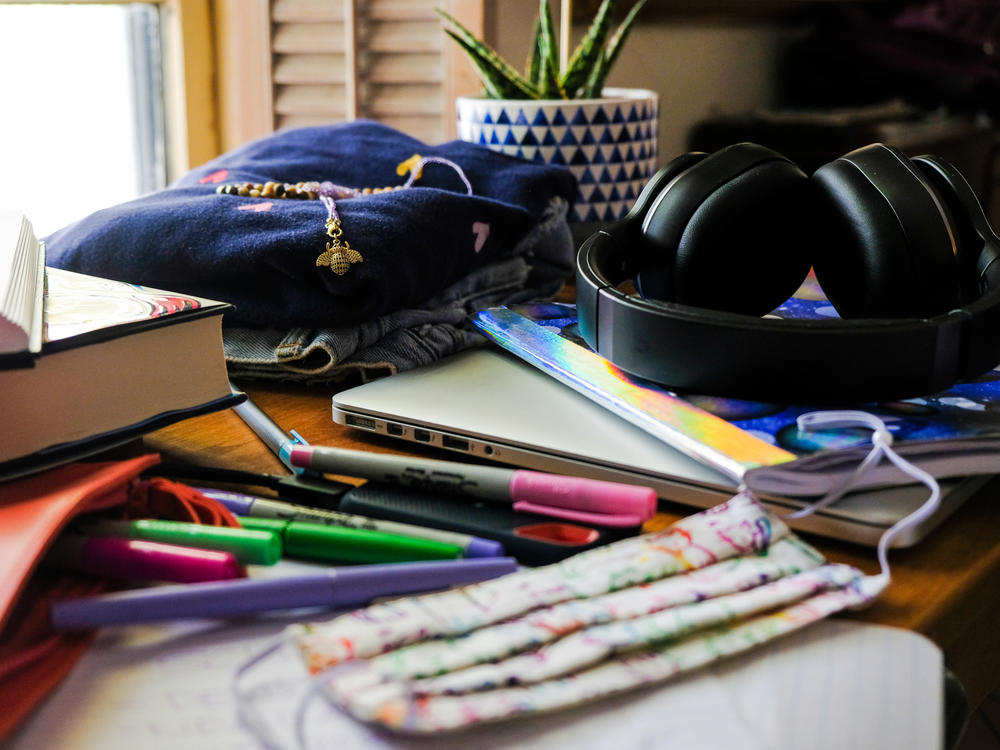Section Branding
Header Content
Families Splurge On Clothes And Electronics In Likely Record Back-To-School Spree
Primary Content
Susan Curp was on a quick run to the store when her 13-year-old daughter spotted something she couldn't pass up: back-to-school sales. Notebooks covered with llamas and palm trees. Pens, pencils and even a case for the scented sanitizer — sparkly, of course.
"I think she's excited to ... get organized and just have a little more normalcy in her life," Curp says.
Curp's daughter has a twin brother who's far less into back-to-school shopping. But he, too, will have to do it — because a lot has changed during the year and a half of the coronavirus pandemic.
"All the kids their age — a lot of them have had a huge growth spurt," Curp says.
Last year's back-to-school shopping season was all about desks and headphones. This year, shopping for clothes is through the roof. Not only have children grown, but they also want the latest styles, or maybe a physical symbol of a fresh start.
That has set back-to-school shopping on a path to a new record, expected to top $37 billion. The National Retail Federation estimates that families will spend an average of $849 on back-to-school items, almost $60 more than last year, when people rushed to set up classrooms at home. College students and their families are expected to spend an average of $1,200.
The industry is watching back-to-school shopping as a key bellwether for economic recovery. Of all the retailers, department stores and clothing stores had the most disastrous 2020. Now they're gearing up for their best year yet.
Most families are stocking up on new outfits in preparation for a return to in-person school. But some are still planning for the possibility of remote schooling, or at least some elements of it.
Once again, electronics are the key driver of record-level back-to-school spending. People are buying more laptops, calculators, tablets and headphones.
Also, younger children are more likely to get a new smartphone this year, says the National Retail Federation's Katherine Cullen: "Maybe a purchase that the family held off on last year as kids were at home, but now they want their child to be able to ... make contact throughout the day."
Some families already got a head start on shopping for the school year when Amazon, Walmart, Target and others held huge summer sales. Now, parents are getting a new financial boost from the government: an increased child tax credit of up to $3,000 for school-age children.
For Miguel Ferreira, who lives outside Boston, that extra money means he might let his 11-year-old daughter join the softball team.
"We can actually consider that rather than going, 'Sweetheart, the gear for that is going to be $100, you know. There's no way we can afford that,' " he says. "There's some wiggle room now, whereas before there was none."
This, of course, is great news for the sports shops that want to sell Ferreira that softball gear.
The expanded tax credit goes hand in hand with another contributor to record-level back-to-school spending: inflation. Ferreira says he has noticed higher prices for everything from stationery to clothes.
"A pair of pants that was previously $50 was now $80," he says.
Ferreira needed those pants for his teenage son, who grew taller during the pandemic, just like Curp's twins. Lucky for Curp, she lives in Austin, Texas, where it's warmer. So her shopping-averse son might just keep wearing his old shorts — for a little bit longer.
Copyright 2021 NPR. To see more, visit https://www.npr.org.

